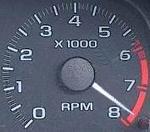what no one here is interested to see the engine internals after 100,000 miles. on a none e85 engine?

Definitely possible to do. I guess as long as your computer can make the right changes, there's really no problem (omitting the possible gasket or rubber line failure). The common problem with E85 is rust and water moisture. As we know, alcohol absorbs water, which can obviously lead to severe problems internally. As long as you can keep the fuel as free from water pollution as possible; this is a non-issue. Straight from the mouth of a GM head mechanic: using E85 will cut the life of your cat in half. Don't know if there's any truth to it, but he's a pretty smart dude and that's what he told me point blank. If anyone knows more about it, chime in.

"In Oldskool we trust"
Did i miss them going over the part where they took a fuel injector apart? or was that not shown?
and the fuel pump business is sort of iffy to me. its going to be cleaner ethanol is eating all the @!#$ up not staining everything. and if the "other" car that had the fuel pump fail at 80,000 keep running the car to low as hell on gas and burning the pump out no wonder it would look like ass.
but besides that E85 from what i hear is the @!#$ and is way cool especially for boosted guys. It equates to like 110+ octane.

No way in hell they just pumped it in and went. Unless they have that much injector left over and the computer can make it go that far.
 i find it amusing that SHOoff has nothing better to do but follow me around & be an unhelpful dick in even cross-forum. - Jon Mick
i find it amusing that SHOoff has nothing better to do but follow me around & be an unhelpful dick in even cross-forum. - Jon Mick
The cylinder wear issue, i pulled the head on my over 200k 2.4 and it has the cross hatch and no ridge. I highly doubt it has had E85 run through it. They had one vehicle that survived just fine, good for them. I guess maybe they never considered that it might have had some E85 compatible parts in it already since GM did have E85 compatible trucks back then. I still wont run E85 in any of my vehicles if they are not listed as being able to run it. Not worth the risk of damaging anything just to save a few dollars per gallon, but use more gallons in the process.

I wouldnt run e85 in any car that wasnt tuned for it. I know for a fact my ecotec will not run it, and it will almost certainly throw a lean code. The stock computer's limits and fuel adjustably are just too small for it to account for the use of e85, since you basically need twice the fuel with e85 to reach lambda 1 (stoich). If I was tuning the car with hp tuners I could run it as long as my tune compensated for it, or if I was running a car with a carb I could re-jet the carb to make it run it (but then it wouldnt be able to run normal gas until I re-jet it again). I guess you could be all ghetto and properly upside your injectors so that the car would give it the right amount of fuel by accident but then if you went to put regular gas in it you'd pull a super rich code.
1994 Saturn SL2 Home Coming Edition: backup car
2002 Chevy Cavalier LS Sport Coupe: In a Junk Yard
1995 Mazda Miata R-package Class=STR
Sponsored by:
Kronos Performance
WPI Class of '12 Mechanical Engineering
WPI SAE Risk and Sustainability Management Officer
Given the BTU (British Thermal Unit) content of E85, roughly about 33% more must be used to equal the energy content of gasoline. Plus, a question of fuel-wash past the rings comes into play with the increased fuel used... But then, there are specially made oils meant for use in alcohol-burning engines that dealership service departments of new-model flex-fuel vehicles carry & are advised to use in maintenance of of said vehicles.
One of two things must also be remembered about flex-fuel vehicles: Their management-system makes use of a sensor placed in-line on the fuel-delivery system that reads the fuel's resistance, telling the ECM what the alcohol content of the fuel flowing through it is. They also contain dual fuel- & spark-mapping to go by, so as to meter & "light-off" whatever the mix is properly in accordance to what the sensor reads.
There's one last thing I feel needs mention about E85: Given the octane content & effect of latent-heat cooling it has, in order to make the most of it I feel it's be best to raise the static-compression considerably (10:1 or more vs. 9.0:1 or less!? C'mon....). After all... everybody knows that the cooler the charge entering the cylinder, the more power. And the more static-compression (Tighter the squeeze), the more efficiency is had from the engine. So cool it... and get tight, E85 lovers!
Go beyond the "bolt-on".
Actually in the newer flexfuel vehicles there is no more tank sensor. The computer just uses the narrow band oxygen sensor and shoots for lambda 1 at idle and cruise. And once it figures out how much fuel it requires to accomplish lambda 1 under those conditions it can figure out how much fuel it needs for all the other conditions you can throw at it. It doesnt matter if the fuel has a lambda 1 that is 14.7:1 (aka normal gas) or a lambda 1 that is 9.7:1 (e85), heck depending on how much the stock programming of the ecu lets its adjust for fuel you could see a fuel who's lambda 1 is 20:1 and have it still be able to achieve stoich and run it (and thats a big if the computer can adjust that far).
1994 Saturn SL2 Home Coming Edition: backup car
2002 Chevy Cavalier LS Sport Coupe: In a Junk Yard
1995 Mazda Miata R-package Class=STR
Sponsored by:
Kronos Performance
WPI Class of '12 Mechanical Engineering
WPI SAE Risk and Sustainability Management Officer
Ah yes... Large-area hyper-sensitive mapping. It worked for the Russians (Red October, anyone?). And preexisting sensor input basing... Just like what the knock-sensor would do upon engine start-up on the KS-feedback Electronic Spark-timing Control found on the early digital computer managed fuel-injected models GM built during the '80s. That makes sense! (Seriously, it does.)
Go beyond the "bolt-on".





